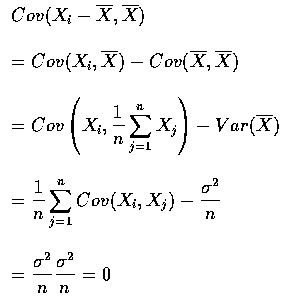The correlationof two random variables X and Y, denoted by
Correlation
Proposition
The correlationof two random variables X and Y, denoted by
![]() ,
is
defined, as long as Var(X) Var(Y) is positive, by
,
is
defined, as long as Var(X) Var(Y) is positive, by

![$\begin{array}{rcl}
0&\leq&Var\left (\displaystyle\frac{X}{\sigma_x}+\frac{Y}{\s...
...a_y^2}+
\frac{2Cov(X,Y)}{\sigma_x\sigma_y} \\ \\
&=&2[1+\rho(X,Y)]
\end{array}$](img6.gif)
In fact, since Var(Z)=0 implies that Z is constant with probability 1, we
see that
![]() implies that Y=a+bX, where
implies that Y=a+bX, where
![]() and
and
![]() implies that Y=a+bX, where
implies that Y=a+bX, where
![]() .
.
If Y=a+bX, then ![]() is either +1 or -1, depending on the sign of
b.
is either +1 or -1, depending on the sign of
b.
The correlation coefficient is a measure of the degree of linearity between Xand Y. A value of ![]() near +1 or -1 indicates a high degree of
linearity between X and Y, whereas a value near 0 indicates a lack of such
linearity. A positive value of
near +1 or -1 indicates a high degree of
linearity between X and Y, whereas a value near 0 indicates a lack of such
linearity. A positive value of
![]() ,
then X and Y are said to be
uncorrelated
,
then X and Y are said to be
uncorrelated


![$\begin{array}{rcl}
Cov(I_A,I_B)&=&P(AB)-P(A)P(B) \\ \\
&+&P(B)[P(A\vert B)-P(A)]
\end{array}$](img15.gif)


Although
![]() and the deviation
and the deviation
![]() are uncorrelated,
they are not, in general, independent. However, in the special case where the
Xi are normal random variables it turns out that not only is
are uncorrelated,
they are not, in general, independent. However, in the special case where the
Xi are normal random variables it turns out that not only is
![]() independent of a single deviation but it is independent of the entire sequence
of deviations
independent of a single deviation but it is independent of the entire sequence
of deviations
![]() .
The sample mean
.
The sample mean
![]() and the sample variance S2/(n-1) are independent with
and the sample variance S2/(n-1) are independent with
![]() haveing
a chi-squared distribution with n-1 degrees of freedom.
haveing
a chi-squared distribution with n-1 degrees of freedom.